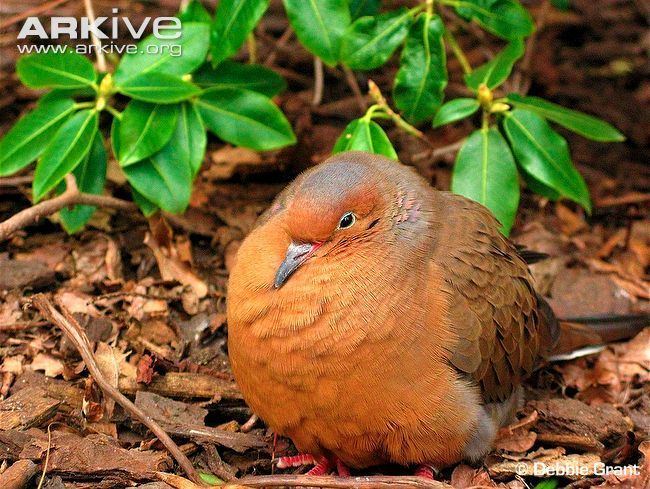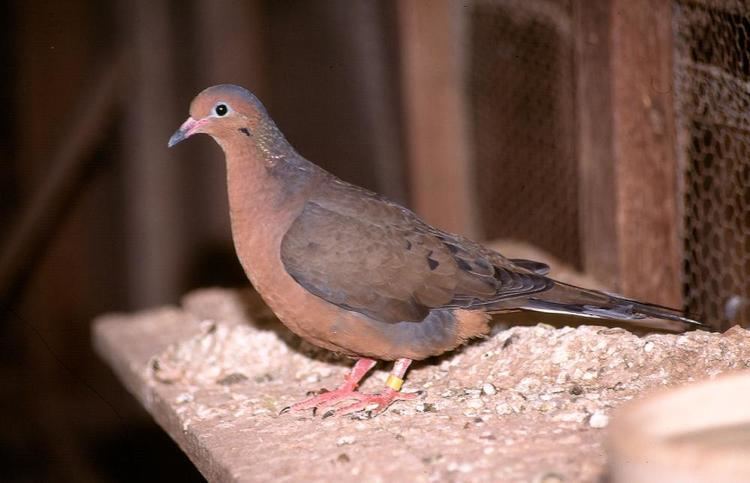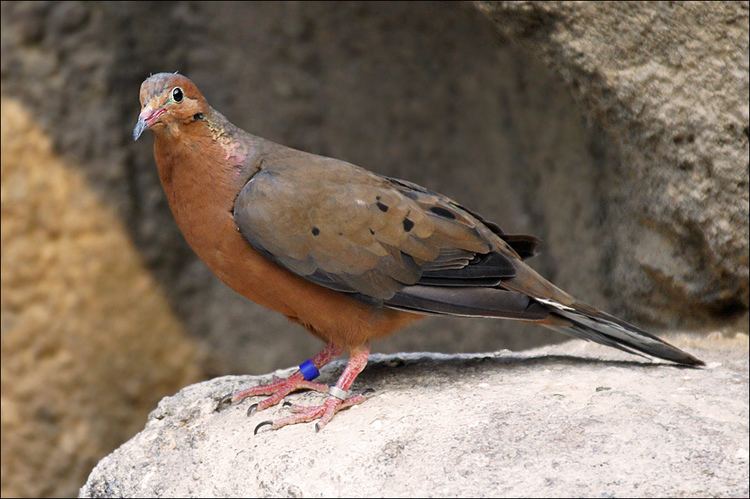Order Columbiformes | Phylum Chordata Scientific name Zenaida graysoni Rank Species | |
 | ||
Similar Pigeons and doves, Bird, Zenaida doves, Crested quail‑dove, New Britain bronzewing | ||
Socorro doves return to mexico
The Socorro dove (Zenaida graysoni) is a dove that is extinct in the wild. It was endemic to Socorro Island in the Revillagigedo Islands off the west coast of Mexico. The last sighting in its natural habitat was in 1972. There are not more than 200 and probably fewer than 100 purebred birds in captivity. A reintroduction program is in the early stages of preparation.
Contents
- Socorro doves return to mexico
- Socorro dove extinct in the wild
- Description
- Ecology
- Extinction in the wild
- Reintroduction efforts
- Specific actions
- References

It is a close relative of the mourning and eared doves, particularly the former and was at one time considered a subspecies. In captivity, it hybridizes with the former and almost all privately owned birds as well as several of the captive breeding programs are known or strongly suspected to be hybrids. These are excluded from the reintroduction program as there is evidence of unique adaptations in the Socorro species. The scientific name commemorates Zénaïde Laetitia Julie Bonaparte and the American ornithologist and artist Andrew Jackson Grayson.

Socorro dove extinct in the wild
Description

The Socorro dove is a medium-sized, principally terrestrial dove with long legs for a zenaida dove. It is 26.5–34 cm (10.4–13.4 in) long and weighs 190 g (6.7 oz) on average. In overall color pattern, it agrees with its relatives. It is considered to be a stronger-colored insular representative of the mourning dove. The male is deep cinnamon on its head and underparts, with an ear streak like its relatives. The nape is blue-grey and the neck has an iridescent pink patch, most prominent after moult. The upperparts are rufous brown. Female and juvenile coloration is slightly duller. The most conspicuous differences from the mourning dove – darker coloration and more well-developed feet – were useful amid the dark lava rock and the shady forests of its island home, where native mammalian predators were absent but constant threats from red-tailed hawks and great frigatebirds were present. The advertising call begins with a disyllabic coo, followed by three single calls, and ends with another disyllabic coo: "Coo-oo, OO, OO, OO, Coo-oo". Each of these 5 elements takes a little less than one second.

The arid and fairly barren Clarión Island, some 400 km (250 mi) west of Socorro, has an endemic subspecies of the mourning dove, Zenaida macroura clarionensis. These birds are roughly intermediate in appearance between the Socorro dove and the mainland mourning doves. It is highly likely that they represent a later colonization by mourning doves (rather than "proto-mourning dove" stock), which evolved its phenotype independently from but in parallel with the Socorro birds. This would mean that predation by great frigatebirds is significant enough to select towards a cryptic darkening of the plumage, as these are the only predators of Z. m. clarionensis. On a semidesert island such as Clarión, birds would be expected to evolve towards lighter plumage – to better withstand the heat and lack of reliable freshwater sources – in accordance with Gloger's Rule.
The upper elevation limit of the doves is 950 m.
Ecology
There is marked behavioral difference to the mourning dove. When Andrew Jackson Grayson discussed the species, he called it the "solitary dove" because he never saw more than one male and one female together. The doves, particularly the adult males, chase away their young as soon as these can fend for their own and the partners split for the time being. This too is believed to be in adaptation to the former dominance of aerial predators, lest local concentrations of birds, let alone young, unexperienced ones, would present easy targets for the hawks. Typical of many birds on mammal-less islands, Socorro doves show little fear of humans or, fatally, cats.
The last habitat in which this dove was found is the low seasonally humid forest above 500 m ASL. Before the introduction of cats, it seasonally descended into the lowlands where it was "common" in March 1953 for example. It may be that this coincided with the peak of the breeding season, when many birds had dependent young and dispersed widely to gather more varied food. This was the case in the Socorro mockingbird, the other mid-sized native landbird of Socorro, which apparently has very similar habitat preferences.
Its last refuge was dominated by endemic Guettarda insularis, Ilex socorroensis and Sideroxylon socorrense, as well as black cherry (Prunus serotina), Ficus cotinifolia fig trees and Psidium socorrense guavas, apparently all native on Socorro. At least at the time of the last record, it seemed to be dependent on intact understorey of Euphorbiaceae (spurges and relatives) and ferns, maybe because cats hunt less efficiently in these dense tangles. It is frugivorous and, as is often the case in Columbidae, might have played an important role in the reproduction of the trees which dominate its habitat. One of these (S. socorrense) is classified as vulnerable by the IUCN. In particular, it was found to associate with the fig trees.
Virtually nothing is known about breeding in the wild. However, each generation is estimated to be about 6.6 years. Parallels in altitudinal migration with the equally solitary mockingbird might be taken as indication that the breeding activity peaked around March–April. In captivity, the female generally lays two white eggs in a nestbox 1–2.5 m above ground. The incubation lasts 14–17 days. The young fledge after 14–20 days.
Extinction in the wild
The Socorro dove is thought to have been extirpated mainly by feral cats, but high levels of understorey grazing by sheep may have limited the population. Human hunting might have temporarily brought down numbers, though little permanent settlement exists on Socorro. Cats were introduced apparently in the early 1970s. They do not seem to have been present in 1953.
The species reproduces no less willingly in captivity than other Zenaida doves, provided its different ecological needs are addressed. Most of the surviving birds are in zoos and other facilities in Germany and the United States. On October 30, 2006, the Socorro dove was successfully bred at the London Zoo. The bird was named "Arnie", after Arnold Schwarzenegger, with reference to his famous line "I'll be back" (on Socorro Island). However, when Arnie was sexed he was discovered to be female. It is hoped that the descendants of Arnie and her relatives can someday soon be reintroduced into the wild. As of early 2006, it was being prepared to remove the sheep and to rid the island of cats. In the meantime, with the maintenance of the remaining birds, stock for reintroduction is being provided. In 2010, by using hunting and telemetry, all sheep have been eradicated from the island. Currently, the problem of cats and house-mouse has yet to be resolved on Socorro Island.
Reintroduction efforts
In order to protect these birds and eventually reintroduce them into the wild, various reintroduction and conservation efforts have germinated. In 1994, the birds' native island of Socorro was declared a biosphere preserve. In addition, as the number of birds in captivity is only slightly above 100, various associations have begun breeding programs. These include the European Association of Zoos and Aquaria (EAZA) as well as zoos in Frankfurt and Cologne. In 2013, the breeding program was successfully introduced into Mexico by the EAZA in collaboration with various government agencies such as the SEMAR, SEMARNAT, and the Mexican Navy. In 2013, six doves were brought to the Africam Safari in Mexico, the first time since their extinction on Socorro that the doves have been brought to Mexican soil.
Specific actions
The original plan was to introduce the birds into Mexico in 2008, however due to import restrictions and permits, the plan was delayed. A stock of viable individuals was kept in the U.S., until finally they were transferred to Mexico in 2013. In 2005 plans were outlined to assess the level of soil erosion on Socorro as a result of vegetation loss. The Mexican Navy claimed to have reduced the sheep population on the island to around 300 with further plans to eradicate all of the sheep on the island between 2008 and 2009. This was accomplished in 2010. Avian Malaria and trichomoniasis were detected during screens other dove populations on neighboring islands in December 2003 and January 2004. As a result, recommendations for protection of the reintroduction population were put forward. In 2008 the Edinburgh and Paignton Zoos sent 12 chicks from their breeding program to the Albuquerque Zoo as part of the collective aggregation effort. In 2006, there was an outbreak of avian influenza in Europe, and therefore 12 doves were sent to Albuquerque Biological Park to create a separate reserve population. Construction of aviaries on Socorro Island began in 2003 and ended in 2005.
In addition to efforts to control cats, humans, and other animals on Socorro Island, efforts are also underway to control locust swarms on the island Outbreaks of Schistocerca piceifrons occur at least twice a year on the island since 1994, and results in damage to native flowers and vegetation.
